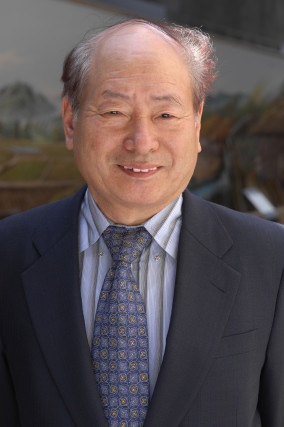Greetings from the Former Director
A Place to Weep Over History and Cultivate Sensitivity

Duk-sang Kang, the former director
The tools of daily life that were used by people in the past are eloquent living witnesses. An ordinary photo of a family can revive memories of bygone days. Identification cards can tell tales of what a particular society wished to prove and what it wanted to monitor. As an example, travel certificates issued to Koreans were all written in red ink. What did red ink signify? Discrimination, prejudice, vigilance, surveillance, and the start of a painful history.
Almost all of the exhibited items in the museum were donated by Zainichi Koreans. Each and every exhibit reveals a personal history. In viewing an elementary school report card where a child’s Korean name was crossed out and changed into a “Japanese” name, we may imagine the child’s puzzled face. From the scissors of a candy seller, we may hear the rhythmic sound of the scissors wielded by a father trying to entertain his children even amidst harsh living conditions. From a grandfather’s photo album, we may feel the hope that filled the air after liberation.
For the younger generations, the exhibits in the museum are historical proof of their grandparents and great grandparents and a history textbook that teaches them about their roots. The museum is a place to cultivate sensitivity and weep over the history of those who came before you. Even just a 30 minute tour of the exhibit can tell you as much as if you had read an autobiography or a book on Zainichi history.
The museum is the only place in Japan that has such a large volume of materials related to Zainichi Koreans. It has been able to grow into such a place due to the kind interest and cooperation from Zainichi Koreans from all over Japan. It can be said that the museum now fulfils a crucial role of exhibiting Zainichi history. We will strive to expand our exhibitions by unearthing and unveiling materials that are still undiscovered. We sincerely hope for the continued interest and expectations from our fellow Zainichi Koreans.
〈Profile of the former director〉
Duk-sang Kang (February 15, 1932 - June 12, 2021)
Duk-sang Kang was born in Gyeongsang-Namdo in 1932, moved to Japan at the age of 2. He completed his undergraduate degree in the School of Humanities and Social Sciences at Waseda University, and his doctoral degree at Meiji University. He is a professor at Hitotsubashi University and an honorary professor at the University of Shiga Prefecture. His major works include The Great Kanto Earthquake (Chūō Kōronsha, 1975), A Portrait of the Joseon Independence Movement (Aoki Shoten, 1984), Korean Student Mobilization: Other Voices From the Sea (Iwanami Shoten, 1997), Biography of Lyuh Woon-hyung 1~3 (Shinkansha, 2002~2018), Korea and China Depicted in Nishiki-e (Iwanami Shoten, 2007), and the compilation Modern Historical Documents (Korea 1~6, Misuzu Shobō, 1963~1976).